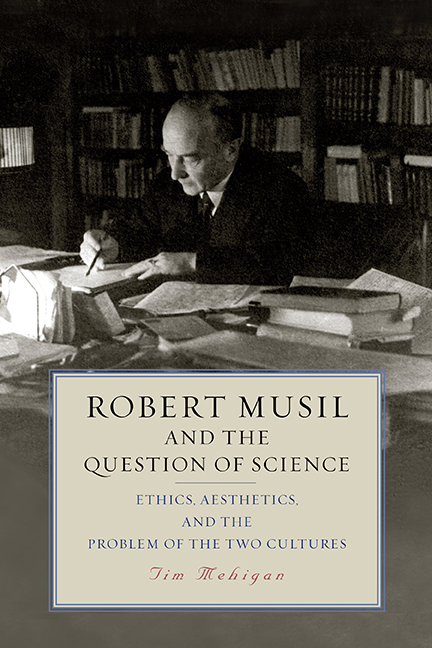Book contents
- Frontmatter
- Contents
- Preface
- Introduction: Musil’s Intellectual Position
- Part I Musil and the Two Cultures
- Part II Aesthetics and Ethics in the Context of the Two Cultures
- Conclusion: “A General Secretariat of Precision and Soul”: Ethics, Knowledge, and Literature after the Fourth Revolution 149
- References
- Index
3 - Musil’s Theory of Vision
Published online by Cambridge University Press: 26 April 2020
- Frontmatter
- Contents
- Preface
- Introduction: Musil’s Intellectual Position
- Part I Musil and the Two Cultures
- Part II Aesthetics and Ethics in the Context of the Two Cultures
- Conclusion: “A General Secretariat of Precision and Soul”: Ethics, Knowledge, and Literature after the Fourth Revolution 149
- References
- Index
Summary
IN AN ESSAY PUBLISHED IN 2007 in the journal Seminar, Rolf Renner outlined a theory of “intermediality” in which similarities discernible in forms of art outweigh any intrinsic differences between them (Renner 2007). In its philosophical assumptions, this discussion runs counter to the direction of Lessing's project in his renowned essay Laocoön (1766), insofar as Lessing considers ostensible discrepancies between sculpture and poetry in the rendering of the time-space continuum to be of sufficient merit to warrant a basic distinction in terms of method and outlook between the two art forms. Lessing in this essay formulates the position that temporal references are not only treated differently in poetry, but in fact have greater significance and value in this medium than they do for the visual arts, whose greater interest is in the spatial dimension and the organization of space. For Lessing, responding to Winckelmann's reflections on the art of antiquity, “intermedial” difference is of high importance and affects the kind of messages we derive from the various art forms. To the classical Laocoön sculpture, for example, Winckelmann had attached a principle of restraint—what he called “noble simplicity and quiet grandeur.” In Lessing's view, it was the nature of the visual medium and the constraints imposed by it that led to such a view, since it would have been unseemly for Laocoön or his sons to express the pain inflicted on them by the serpent directly. By contrast, for the “temporal art” of poetry, the Roman poet Vergil in the Aeneid throws caution to the wind in conveying the suffering of Laocoön. Vergil's Laocoön, in the medium of poetry, gives the emotions free range.
Critical responses to the Laocoön statue group remind us of the importance it possesses for humanist discourses in the early modern period. Whether Laocoön yields to the pain he suffers or whether he rises above it is of great interest, but of even greater significance is how the various art forms treat the subject of pain. On the eve of the emergence of the modern in the era of the late Enlightenment, pain is a “neuralgic” point requiring its depictions to be differentially allocated. That the modern will depart from the logic of this allocation is clear from Renner's assumptions.
Information
- Type
- Chapter
- Information
- Robert Musil and the Question of ScienceEthics, Aesthetics, and the Problem of the Two Cultures, pp. 51 - 62Publisher: Boydell & BrewerPrint publication year: 2020
